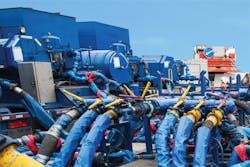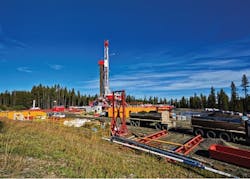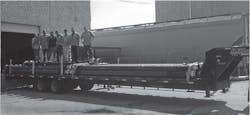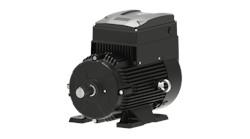Before 2010, hydraulic fracturing (fracking) was an almost unheard-of term to most people in the U.S. and around the world. It quickly became a household name and would be in the news daily for years to come. Little did we know that it, paired with horizontal drilling, would represent such a huge economic impact across virtually every industry in our country, from hotels to equipment manufacturers to support services.
Not your traditional hose
What was most intriguing was its effect on the industrial hose market. This was an escape from the traditional hose business, which mainly concentrated on heavy industries such as steel, agricultural, and pulp and paper. Operators and industrial hose manufacturers quickly learned that industrial hoses were one of the most critical parts of these new processes. The applications ranged from water delivery to drilling/frac site to the drilling hoses themselves. Each process had different criteria for these kinds of hoses.
Traditional hose use was attempted in these different applications, but these hoses were inadequate in most cases. Manufacturers got quite aggressive in developing hoses to meet these demands, which included higher pressures and larger volumes than industrial hose manufacturers were accustomed to. The product depth to accomplish all that was required in these applications was not available. Challenged by these new processes and pressure/volume requirements, many of the large contractors counted on hose manufacturers to provide products that would not fail in the field before a job was completed.
Strong hoses able to withstand the rigors of the environment and materials that flow through them were required in several phases of the drilling and completion processes. These included:
- Moving water used to blend drilling mud and fracking fluid (which includes proppants, chemicals and water)
- Pumping drilling mud downhole
- Pumping cement downhole
- High-pressure pumping fracking fluids downhole
- Hose for water delivery
Water is essential in every drilling and completion operation because each well requires several millions of gallons of water for the process. Since many well sites are in remote areas, getting water to these sites is not always easy. In the best cases, a water source is close to the site where long runs of hose could be used to transfer the water up to 10 miles to the site. This is accomplished by a series of high-volume pumps and large-diameter hoses. The problem is that these runs are typically across rough terrain and heavily wooded areas.
The hoses used could not handle this terrain, nor the large volumes of water pumped across a long period. The hose manufacturers also had to consider the environmental effect of hoses and ensure that they did not leak during this transfer. For most hose companies, little domestic inventory for this type nontraditional hose was available, so a mad dash occurred to procure it from Europe and Asia where it was more common.
One manufacturer realized that a polyvinyl chloride (PVC) hose was ineffective in this application, so it moved to a PVC/nitrile-blend hose that was rated at 200 psi. It was a rugged hose, reasonably priced, that could handle the volumes with no problems and was easily deployed in the field. The typical hose had an 8-inch diameter with grooved fittings, which are common in this application.
A better hose was on the market – polyurethane (PU) – that could handle higher pressures and withstand wear several times better than the PVC/nitrile hose. The problem was that the cost was double. A few of the water transfer companies saw the value and used it, but they were in the minority.
During the next few years as demand rose, the price of the hoses dropped tremendously and toward the end of the boom almost equaled that of a traditional hose. As business ramps back up, this PU hose will replace the PVC/nitrile hose. In addition, when water transfer companies purchase this hose, it is usually in 2- to 3-mile increments in 660-foot lengths.
Once at the frac site, water is stored in a series of tanks and holding ponds for use in many drilling and completion processes. In selecting proper hoses for these processes, safety is the main concern because higher than normal pressures are used as well as many different types of chemicals. Knowing the chemicals used and pressures required is important to properly select a hose.
Drilling platform
Hose for the drilling site
During the drilling process, a mixture of water, mud and drilling chemicals or lubricants is used. This mixture can be quite demanding on hoses. Many manufacturers have developed specific blends of hose material to withstand this process. They should typically be rated at 400 psi or greater to prevent premature failure. Typically, the recommendation is for the hoses to be crimped on the termination ends in lieu of band clamped for safety reasons. This hose is typically used to transfer these liquids to the mixer tanks that blend and supply the mud pumps.
Drilling hoses
Once drilling starts, the drilling fluids are pumped at high pressures into the mud pump and drill hoses. Selecting these hoses is crucial, and they should only be supplied by manufacturers that are certified to build them. These are the costliest hoses on the rig and are the most crucial in the operation. Most drillers require American Petroleum Institute (API)-certified hoses built to a tough standard. These hoses are responsible for carrying the cutting fluid and mud to the wellhead and are used to remove the cuttings from the hole. Properly sizing these hoses is important because they are in constant motion in traveling loops.
Failure can cause a rig to stop drilling operations until the affected hose is replaced. These hoses’ times of service should be tracked, and they should be replaced frequently (typically every 12 months). They should also be inspected during operation for any unusual pulsing in the hose assembly. Pulsations can typically occur if compensator units malfunction. If this occurs, the hoses start acting as the compensator and can cause premature failure during drilling.
Cementing hoses
After drilling is completed and the pipe is in place, cement is pumped downhole to form the well casing. Careful selection of a cementing hose is also important because it involves pumping a heavy volume of material at higher than normal pressures. Abiding by the API guidelines when selecting this hose is also paramount.
This hose is prepared to depart for duty at a fracking site.
Frac hoses
After the casing is in place, the well is ready for the fracking process. This is when most hoses are used in the process. During fracking, water is mixed with chemicals and proppants, typically sand, and sent downhole at high pressures to stimulate the well to produce more oil or gas. A series of tanks on site are connected with hundreds of feet of hose and are sent to a common blender before being pressurized for delivery downhole.
These hoses are designed to withstand the harshest of applications and weather conditions and traditionally have added outer protection to prevent wear on the outside of the hose. The hoses must be designed to handle at least 400 psi of pressure. Even though these pressures are rarely reached, this capacity adds extra strength to withstand the conditions.
One of the most demanding parts of plumbing these units is routing. Routing these hoses as free as possible is important. Sometimes tight bends are unavoidable in this process. However, the tighter the hose bends the more vulnerable that hose becomes once pressurized. The outer cover of the hose must also be protected because abrasion is the number one cause of hose failure in the field. More than 90 percent of all hose failures occur from the outside in and are not necessarily caused by the media being conveyed.
Game changer
The onshore drilling industry helped redefine traditional hose use. Hose manufacturers were faced with the most challenging obstacles experienced to date. Manufacturers spent most of their energy making their hose offerings more affordable in a shrinking market amid global pressures. This industry led to brand new products to suit the need of the oil operators and developed these new products from the ground floor by spending time in the field with the end users. Many of the products that were developed became standard product offerings replacing traditional products. Although the demand was for a less costly hose, manufacturers and domestic quality vendors worked together to develop safe products at a competitive price.
Even though this market segment has experienced a slowdown during the past few years, the gained experience and knowledge in this industry will help bring back the fleets with proper hoses once these companies deploy their equipment in the field again.
Much excitement surrounds this new phase of the industry as drilling ramps back up in the coming months.
A 28-year hose industry veteran, Joe Lark is Motion Industries’ product manager for hose. Before his eight years with Motion Industries, Lark spent 20 years with Monroe Rubber and Plastics Supply Company (now a unit of Motion Industries), with the last 10 as president/owner. He is a past president of the National Association of Hose and Accessory Distribution (NAHAD) and is the committee lead for developing “Hose Assembly Guidelines” for NAHAD. For more information, visit motionindustries.com.





